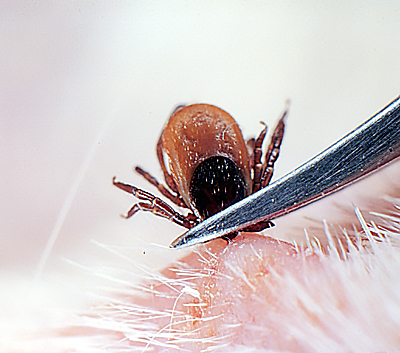Ticks are sneaky critters that are commonly found in wooded and grassy areas; they await the opportunity to attach themselves to humans and animals as they pass by. Ticks are very small in size; some as small as a grain of sand and therefore very difficult to detect.
Aside from the “yuck” factor in having a tick attach themselves to you or your pet to feed, ticks can carry and transmit Lyme disease. The Blacklegged Tick (also referred to as a “Deer Tick”) poses the threat of transmitting Borrelia burgdorferi, the bacterium that causes Lyme disease in humans and animals. It is important to know that not all types of ticks are known to transmit disease but you should always take precautions when walking in grassy/wooded areas.
Symptoms of Lyme disease vary in severity and may not appear until months after infection. The most common symptoms your pet may display are:
- Recurrent painful joints that lasts 3–4 days, sometimes accompanied by loss of appetite and depression
- Reluctance to move, or a stiff, painful gait
- Swollen joints that are warm to the touch
- Leg pain or pain throughout the body
- Fever, fatigue, and swollen lymph nodes
More serious complications include damage to the kidneys, and even heart or nervous system disease.
It is recommended that pet owners thoroughly check their pet’s for ticks promptly after spending time outdoors during the Spring, Summer and Fall months. Pay extra attention to the areas around your pet’s head, neck, ears, gums and paws. If you do find a tick on your dog, it is important to remove it properly as soon as possible to limit infection:

- Use a fine-tipped pair of tweezers to grasp the tick as closely to the dog’s skin as possible.
- Pull the tick’s body away from the skin with a straight, steady motion.
- After the tick is removed, wash your dog’s skin with soap and water.
- Call your veterinarian about having the tick tested. The tick can be kept in a bag in the freezer until then.
Never use petroleum jelly, a hot match, nail polish or other products to remove a tick.
Early prevention using monthly chewable or topical skin solution to deter and kill ticks is key, as they become active when temperatures reach only 4°C. Although there is no Lyme vaccination for humans, it is available for dogs. Both options should be discussed with your veterinarian to determine what is best for your pet.
Sources:
https://www.ovma.org/ticks-and-lyme-disease-keeping-pets-safe-and-healthy/
https://www.petmd.com/dog/conditions/infectious-parasitic/c_dg_lyme_disease
http://www.pethealthnetwork.com/dog-health/dog-diseases-conditions-a-z/lyme-disease-dogs
https://www.health.com/condition/lyme-disease/tick-borne-illness-facts

